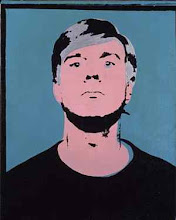 |
| Sarah Lucas, Fighting Fire with Fire, 1996 |
Performing for the Camera is at Tate Modern until 12 June 2016.
The camera invites
performance: the lens turned towards us compels, at the very least, an
adjustment of expression and gaze. It may be that the camera doesn’t lie – but
we do, when we create these little fictions for photographs. The contemporary
apotheosis of this performance is the selfie where we become director, subject
and audience. (I enjoyed David Bailey’s recent comments on the topic: … somebody said ‘what do you think of
selfies?’... I thought it meant masturbation. And then they told me what it
was, and I realised it is masturbation! – see short video here.)
The publicity for Performing for the Camera, featuring
images by Romain Mader and Amalia Ulman, suggested that it was this
narcissistic trope of the selfie that was the exhibition’s subject (albeit,
that both Mader and Ulman self-consciously construct fictional identities).
 |
| Amalia Ulman, from Excellences and Perfections, 2014 |
However,
the exhibition is broader and more interesting than that, taking as its main
focus the documentation of Performance Art as well as performance enacted for
the camera.
The exhibition opens with
Yves Klein’s well-known Leap into the
Void (1960). The photograph shows
Klein in mid-flight from a first floor ledge with, apparently, nothing to prevent
his inevitable fall onto the street below except for, presumably, his faith in
immaterialism and transcendence - and the viewer’s suspension of disbelief. It
is obviously a trick: a composite photograph – but very persuasively done.
Here, however, it is ‘explained’ with the display of the photograph showing
Klein’s friends waiting below with a tarpaulin to catch him. Klein (who died in
1962) was insistent that the trick should not be revealed, so it seems a little
sad that is it so bluntly revealed here. Once the ‘magic’ is explained – it is gone.
Leap
into the Void is
unequivocally Klein’s ‘work’; however, the photograph was made by Harry Skunk
and János Kender; as were the many, many photographs of Klein gleefully
directing his ‘living paintbrushes’ (naked women smeared with blue paint); in
fact, one of the revelations of this exhibition is that the photographs of
Skunk/Kender were key to much Performance Art of the 1960s and 70s – here we
see their work with Niki de Saint
Phalle, Marta Minujín, Eleanor Antin, Yayoi Kusama, Dan Graham and Merce
Cunningham, besides Klein; typically, in such instances, the photographer is
effectively merely a technician in the archival process. Clearly this raises
questions about who the artist is and where the art is – this is intrinsically
problematic with performance given that, in these examples, it only really
exists in the ‘live’ moment; another section of the exhibition looks at
events/performance which is made specifically to be photographed. (Sometimes
the point of the photograph is ambiguous – I looked with pleasure at Babette
Mangolte’s gorgeous, misty rooftop view across New York dominated by that
city’s, characteristic quirky water towers for some time before I realised that
I was supposed to be attending to the individual figures from Trish Brown’s
Dance Company distributed across the roofs.
Much of this exhibition
presents familiar material – given that reproducibility is a defining characteristic
of the medium this is often a potential problem for photography exhibitions:
when work is exhibited as small, framed black and white prints (as much in the
first few rooms, here, is) I can’t help feeling that seeing them in a book (such
as the excellent catalogue) would be more effective; when those pictures are
arranged in rows that begin near to the floor and rise to considerably above
head height (as with the display of Stuart Brisley) it is just irritating.
However, there is work
here that looks fresh and work that is displayed at a quality and scale that makes
the most of gallery presentation.
Work that I particularly
enjoyed included David Wojnarowicz’s series Arthur
Rimbaud in New York; Jemima Stehli’s Strip;
Hans Eijkelboom’s creepy portraits of himself posing with other people’s
families; and Samuel Fosso’s African
Spirits (his self-portraits as Angela Davis, Malcolm X and other
significant figures make a refreshing juxtaposition to Cindy Sherman’s more
familiar Untitled Film Stills.)
I also loved the wall of
Joseph Beuys posters!
Read reviews by AdrianSearle, Waldemar Januszczak, Mark Hudson, Rachel Spence.
(Click on images to enlarge.)
 |
| Yves Klein, Leap into the Void, 1960 - photograph by Skunk-Kender |
 |
| Yves Klein, Anthropometries of the Blue Period, 1960 - photograph by Skunk-Kender |
 |
| Babette Mangolte, Trisha Brown: 'Roof Piece', 1973 |
 |
| Hans Eijkelboom, With My Family, 1973 |
 |
| David Wojnarowicz, from Arthur Rimbaud in New York, 1978-9 |
 |
| Francesca Woodman, Untitled, Providence, Rhode Island, 1976 |
 |
| Jemima Stehli, from Strip, 1999-2000 |
 |
| Samuel Fosso, African Spirits: Angela Davis, 2008 |
 |
Joseph Beuys, La Rivoluzione Siamo Noi, 1972
|













No comments:
Post a Comment